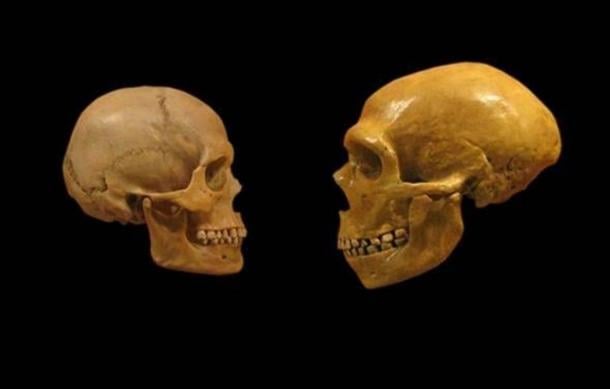🔴 Website 👉 https://u-s-news.com/
Telegram 👉 https://t.me/usnewscom_channel
A fascinating new study has revealed a surprising possible source for the presence of autism in the human population. Performing a careful analysis of human genetic variations that have been linked to interbreeding with Neanderthals, researchers have found evidence to suggest that our long-extinct Neanderthal cousins may have given us DNA that contributes somehow to the development of autism.
The DNA in question has also been connected to other troublesome traits in humans, including language delay and repression and various types of intellectual disabilities.
In an article just published in the journal Molecular Psychiatry, a team of scientists from Clemson University in South Carolina and Loyola University in New Orleans explain how they were able to discover this unexpected genetic connection between Neanderthals and Homo sapiens, or modern humans. The data they obtained showing the sharing of autism-related genes emerged from a study of Neanderthal DNA in three ethnic populations: African-Americans, white Hispanic Americans, and non-Hispanic white Americans.
“This is the first study to provide strong evidence for the active role of a subset of rare, as well as some common, Neanderthal-derived alleles in autism susceptibility in multiple major American populations,” the study authors wrote, noting the historical significance of their results. As of now there is no specifically identified cause for autism, which means any research that sheds light on its origins can be considered groundbreaking.
Regardless of the importance of this find, the scientists acknowledge that more study of the genomes of individuals diagnosed with autism will be required to reaffirm their results. But based on what has been discovered so far, the scientists fully expect their findings to be confirmed once more of this type of research has been performed.
Exploring the Genetic Legacy of Neanderthals in the Human Genome
Neanderthals disappeared from the Eurasian land mass approximately 40,000 years ago. It is generally conceded that the pressures of trying to coexist with modern humans, who migrated to Eurasia from Africa in large numbers around 48,000 years ago, ultimately doomed them to extinction.
Comparative studies of the human genome and of samples of Neanderthal DNA recovered from skeletal remains leave no doubt that the two species interbred. It seems the exchange of genetic material between the two took place over the course of several thousand years, and as a result about two percent of the genomes of modern people of European and Asian descent consists of Neanderthal DNA (although some East Asians have up to four percent).
Comparison of Modern Human and Neanderthal skulls from the Cleveland Museum of Natural History. ( hairymuseummatt DrMikeBaxter/CC BY-SA 2.0)
Interestingly, different people have different selections of this DNA, and overall about 20% of the genetic material Neanderthals possessed can be found in one human population group or another.
As for the specific genetic variants linked to autism, these exist in about one percent of the human population, although that percentage may vary based on ethnicity and genetic heritage.
“In our study, we’ve found that autistic people, on average, have more rare Neanderthal variants, not that they have more Neanderthal DNA in general,” Emily Casanova, the new study’s lead author and a Loyola University assistant professor of neuroscience, told the science publication PsyPost. “That means that while not all Neanderthal DNA is necessarily influencing autism susceptibility, a subset is.”
In their research, the scientists from Clemson and Loyola Universities used a technique known as exome genetic sequencing to search for DNA linked to Neanderthals in the genomes of a group of people with autism, and in their siblings who were unaffected by the disorder. Using this sophisticated analytical methodology, they were able to identify 25 Neanderthal genes called single nucleotide polymorphisms (SNPs) that were notably more common in the individuals diagnosed with autism. Some of these SNPs were quite rare, meaning they aren’t frequently found in any human genome.
Graphic reveals Total NeanderScores between autism and control groups. (Pauly, R., Johnson, L., Feltus, F.A. et al./Nature)
As previously mentioned, the suspicious DNA sequences were discovered most frequently in samples obtained from African-Americans, white Hispanic Americans, and non-Hispanic white Americans.
According to researcher Emily Casanova, this discovery will open some eyes in the genetic research field.
“I was rather surprised that many of the Neanderthal-derived variants we found that were associated with autism dramatically varied by ethnic group,’ she stated. “To me, it suggests that our tendency to ‘whitewash’ genetics and ignore variants that aren’t implicated across all genetic backgrounds means that we’re missing out on a lot of important genetic factors.”
Tellingly, this DNA was also much more common in individuals from families that had a history of high rates of autism. This finding offers strong confirmatory evidence that the rare DNA sequences that originated in Neanderthals really are a major factor in the development of this neurological condition.
For Good or Ill, Neanderthals Helped Make Us Who We Are
While they were looking exclusively at the connection between Neanderthal genes and autism, the researchers believe that other links between Neanderthal DNA and modern human characteristics will eventually be discovered.
“We hope this research will lead to further investigation into the ongoing influences of ancient hybridization between H. sapiens and Neanderthals in brain development, human intelligence, and overall human health, as well as spur work into additional clinical resources for this complex population,” they wrote in their Molecular Psychiatry article.
Intriguingly, the researchers plan to launch a new and separate study that will examine traces of Denisovan DNA found in the human genome, to see if it may have some relationship to the development of autism in Asian and Native American populations. Since the Denisovans lived in Siberia before going extinct, as did some of the descendants of modern Asians and Native Americans, this would seem to be a possibility worth exploring.
Top image: Neanderthal DNA might play a role in autism. Source: BillionPhotos.com/Adobe Stock
By Nathan Falde


